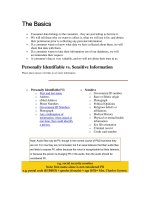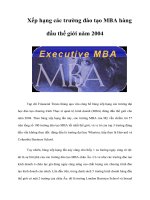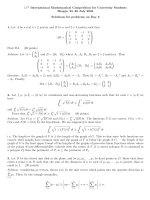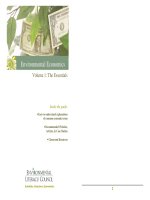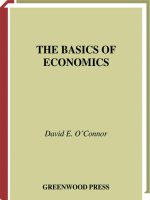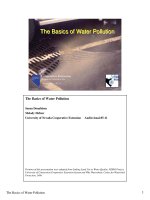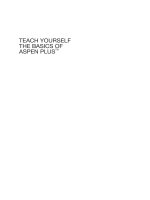- Trang chủ >>
- Khoa Học Tự Nhiên >>
- Vật lý
tony cleaver - economics - the basics - (routledge 2004)
Bạn đang xem bản rút gọn của tài liệu. Xem và tải ngay bản đầy đủ của tài liệu tại đây (840.71 KB, 229 trang )
ECONOMICS
THE BASICS
Economics: The Basics provides a fascinating introduction to the
key issues in contemporary economics. Comprehensive and easy to
read, it covers major microeconomic and macroeconomic aspects
including:
●
demand, supply and price theory;
●
monopoly and competition;
●
inflation and unemployment;
●
money, banking and government policies;
●
international trade;
●
developmental and environmental issues.
Through case studies ranging from the coffee plantations of
El Salvador to the international oil industry and the economic
slowdown in Japan, this book addresses the fundamental theoretical
and practical issues in economics.
This accessible guidebook is essential reading for anyone who
wants to understand how economics works and why it is important.
Tony Cleaver is Vice-Master of Grey College and lecturer in the
Department of Economics and Finance at the University of
Durham, UK.
© 2004 Tony Cleaver
You may also be interested in the following Routledge student
reference titles:
FIFTY MAJOR ECONOMISTS
STEVEN PRESSMAN
THE ROUTLEDGE COMPANION TO GLOBAL ECONOMICS
EDITED BY ROBERT BENYON
BUSINESS: THE KEY CONCEPTS
MARK VERNON
FIFTY KEY FIGURES IN MANAGEMENT
MORGEN WITZEL
INTERNET: THE BASICS
JASON WHITTAKER
© 2004 Tony Cleaver
ECONOMICS
THE BASICS
Tony Cleaver
© 2004 Tony Cleaver
© 2004 Tony Cleaver
First published 2004
by Routledge
2 Park Square, Milton Park, Abingdon, Oxon, OX14 4RN
Simultaneously published in the USA and Canada
by Routledge
270 Madison Avenue, New York, NY 10016
Routledge is an imprint of the Taylor & Francis Group
© 2004 Tony Cleaver
All rights reserved. No part of this book may be
reprinted or reproduced or utilised in any form or by
any electronic, mechanical, or other means, now
known or hereafter invented, including photocopying
and recording, or in any information storage or
retrieval system, without permission in writing from
the publishers.
British Library Cataloguing in Publication Data
A catalogue record for this book is available from the British Library
Library of Congress Cataloging in Publication Data
Cleaver, Tony, 1947–
Economics: the basics / Tony Cleaver.
p. cm. – (The basics)
1. Economics. I. Title. II. Series: Basics (Routledge (Firm))
HB171.C655 2004
330–dc22 2004002732
ISBN 0–415–31411–9 (hbk)
ISBN 0–415–31412–7 (pbk)
This edition published in the Taylor and Francis e-Library, 2005.
“To purchase your own copy of this or any of Taylor & Francis or Routledge’s
collection of thousands of eBooks please go to www.eBookstore.tandf.co.uk.”
ISBN 0-203-49602-7 Master e-book ISBN
ISBN 0-203-57327-7 (Adobe eReader Format)
PARA MARIA CRISTINA
© 2004 Tony Cleaver
CONTENTS
1 Wealth and poverty
2 Prices, markets and coffee
3 The business of supply
4 Inflation and unemployment – boom and bust
5 Money, banks, bubbles and crises
6 National income, world trade and multinational
enterprise
7 Can we reduce poverty and protect the environment?
Glossary
© 2004 Tony Cleaver
1
WEALTH AND POVERTY
Planet Earth is a unique and immensely rich supporter of biological
life-forms.
The most successful life-form is, of course, humankind and it has
exploited the planet’s richness to spread rapidly across the globe – and
it has also, for some, developed lifestyles that are unprecedentedly
sophisticated and luxurious.
Dominant though the species has become, however, two important
observations must be made:
●
First, however richly endowed the Earth may be, its resources
are not limitless. It is becoming increasingly apparent that the
exponential growth in human activity is damaging to the
planet’s ecology. As more resources are commandeered for
human consumption so not only do other life-forms lose out
in direct competition but also there is the danger that future
generations of humankind itself will be deprived.
●
Second, just as other species have been unable to compete for the
control of Earth’s resources against the dominant life-form, so
within humankind there are great differences in the ability of
some to compete and succeed. A relatively small minority of the
peoples on the globe enjoy great riches. A very much larger
fraction of humankind survives in comparative poverty.
Terms in capital letters are included in the Glossary.
© 2004 Tony Cleaver
Unlike primitive plants and animals, however, what makes
humankind different from all other species on the planet is our
capacity for choice. We are not driven solely by instinct to the ends
we find ourselves occupying. We can choose our own destiny.
Acting on our own as individuals or acting together in society, we
are blessed with the capacity to influence future outcomes.
Economics has been described as the science of choice. In the face
of limited resources, human society has evolved systems of decision-
making that choose whose wants are to have priority, in what
manner resources are to be exploited and whether – in the end – we
make guns or bread and butter.
Whichever decision-making system society employs, however, it
is in the nature of economics that the answers it comes up with
cannot please all of the people, all of the time. Because fundamental
issues and disagreements are at stake here, they have excited
the passions of humankind throughout history. Revolutions have
erupted, wars have been won and lost and demonstrations continue
to this day in various cities and nations of the world about
the proper distribution, use and abuse of the fruits of the planet.
This text attempts to study these things dispassionately, to
analyse and achieve an objective understanding of the basic
economic questions that concern us all: how wealth is created, how
it is distributed amongst us and what is sacrificed in the process.
We begin by considering market, command and traditional
forms of economic organisation. In later chapters, we go on to study
the role of prices, the nature of production, and issues of inflation,
unemployment and international trade. In so doing we adopt the
economists’ rational, scientific approach to our subject matter but –
as I hope you will see – throughout this analysis we never stray far
from issues of topical and controversial interest that economics is
designed to illuminate.
In this respect, consider the criticism implied earlier. Some
observers allege that we have squandered the riches of the Earth in
creating inequitable opulence – catering for the greed of a few
powerful parties whilst ignoring the needs of all other inhabitants
of the planet. Is this true? If so, how has it come about? And what,
if anything, should be done about it?
In order to address these questions, it is worth pointing out at
the outset the difference between matters of fact and those of
© 2004 Tony Cleaver
opinion. That is, between questions of POSITIVE ECONOMICS, which
can be answered by resort to hard evidence and those of
NORMATIVE
ECONOMICS
, which require the application of value judgement.
Modern economists attempt to redefine most questions so that they
may be couched in terms of the former, avoiding the latter (or at
least identifying their own biases) so that the reader can make up
his/her own mind.
That the Earth’s riches are consumed more by some than by
others can be quickly demonstrated. Consider an A to Z of the
world’s nations: One quick measure of relative wealth is the
purchasing power of the average citizen in, say, Austria compared to
Zambia; Bangladesh compared to the USA. The World Bank gives
the data as shown in Figures 1.1 and 1.2 for the year 2000.
24,600
1,530
31,910
720
Austria Bangladesh USA Zambia
Figure 1.1 US$ average income per capita (purchasing power parity).
3.14
0.1
8.35
0.14
Austria Ban
g
ladesh USA Africa*
Figure 1.2 Primary energy consumed per person (tons of oil equivalent).
Note
* Figures for Zambia are unavailable. The average for all African countries except
Algeria, Egypt and the Republic of South Africa given instead.
© 2004 Tony Cleaver
Another yardstick would be to compare the consumption of
primary energy sources of the average person in each country –
since this is a direct measure of how much of a basic and essential
resource (such as oil) is being used up by differing peoples.
These are crude measures. Many more sophisticated and more
accurate surveys can be quoted but the basic point is made: there
exist great extremes of wealth and poverty amongst the peoples of
the planet.
How such an unequal distribution has come about is a much
more difficult question of positive economics. It is, in fact, an
inquiry that will run all through this book as an undercurrent that
flows behind the various theories and analyses which form the
backbone of this subject.
What, if anything, should be done about global inequality is, of
course, not a question of positive economics at all. Like a scientist
studying the workings of the solar system, or the internal organs of
some animal, the economist is responsible for publishing the
evidence and identifying what might happen if you make this
change or that to economic systems but he/she has no more right
than anyone else to say what ought to happen in this world.
It is always easy to ask important questions in economics. It is
easy also to make colourful and outrageous claims about the nature
and conduct of economic affairs. (Have certain people really squan-
dered the riches of Earth?) It is not always easy, however, to give
balanced, objective and accurate responses to such questions and
assertions. That is nonetheless the challenge of positive economics.
THREE DECISION-MAKING SYSTEMS
Let us return now to the study of decision-making systems that
communities may adopt to organise their economic affairs. There
are three examples.
First, consider the economic activity within a small, student-run
community – such as in a university college or hall of residence. In
this example, we can imagine a fairly active social life exists,
perhaps led and organised by a student committee: putting on
discos, arranging a regular supply of drinks and snacks, maybe on
occasions inviting outside agents and artistes to come and entertain
the residents.
© 2004 Tony Cleaver
Now contrast this with the economic life of a large town or city:
an enormous range of industrial, commercial and personal services
are provided – too many to briefly enumerate.
Third, at the opposite extreme, we can consider the economic
organisation of a small family home where housekeeping, main-
tenance and family care takes place.
How is it decided in each of these communities what goods and
services should be provided; how (where, when and by whom) these
commodities should be produced and who should enjoy the benefits
of their consumption? Decisions as to what is produced, and how
and for whom, may be taken in very different ways in these three
examples.
Small college communities where everyone knows one another
can often be run very democratically – people being elected for
office and then asking around what goods should be ordered, what
sorts of things people want to get done, etc. An efficient
CENTRAL
PLANNING
mechanism may evolve – the community’s wants are
surveyed, passed up to the decision-making committee who then
issue orders to outside suppliers or delegate production to internal
groups (the bar committee, the dance organisers, etc).
In a family home, there is unlikely to be any formal election of
senior officers. Most economic decisions are taken by parents and
family elders and roles within the family evolve slowly according to
TRADITION and the circumstances of individuals.
Most of the economic activity in a large city, however, is deter-
mined not by planning, nor by social custom but by the dictates of a
free
MARKET. If there is sufficient demand for a product or service
then, subject to its lawful production, it will be provided.
(Governments can outlaw certain trades such that supplies are
severely cut back – but so long as people are willing to pay high,
BLACK MARKET prices production will take place anyway. The free
market can subvert government.)
These three decision-making systems introduced here can be
found in operation all over the world. Their precise application in
any one theatre of human activity will depend on the institutions
and practices of the country concerned – some industries and some
countries may demonstrate a distinct preference for one system
above the rest; another economic organisation may rely on a combi-
nation of all three. Industry in almost any country will demonstrate
© 2004 Tony Cleaver
some element of all three decision-making systems acting together
but let us look for examples where each regime can be studied more
or less on its own.
TRADITIONAL AGRICULTURE
As an example of traditional practice, there is no better showcase to
be found than to observe the work of the millions of people around
the world tied to subsistence agriculture. They are bound to a
system that – relative to other societies – has seen little change over
centuries.
Evidence suggests that farm workers in poor countries are not
themselves resistant to change – indeed they may respond rapidly
to genuine opportunities to improve their welfare – but that given
the circumstances in which they find themselves, their traditional
agricultural practices are in fact rational and efficient outcomes that
have evolved over generations of trial and error.
What goods does such a society choose to produce? Those that
experience shows to be the most reliable.
In farming some of the poorer lands on the planet, where
climatic conditions may vary, where ownership of land and one’s
place in society is traditionally determined and where government
is remote and as reliable as the wind, those who work the land tend
not to take undue risks. They produce therefore what they know
they can count on, using traditional technology that is home-grown
and suited to the terrain.
Traditional agriculture tends to be self-sufficient because it has
to be. To become dependent on a number of external suppliers in
poor countries is to risk losses when they fail you. And losses in
this context means not only losing crops or livestock but losing
your life as well.
Social custom therefore determines much of the economic
organisation that takes place in poor rural communities. What, how
and for whom production takes place is decided by traditional prac-
tices that have evolved according to the particular institutions of the
society in question. Within these given parameters, such economic
organisation can often be highly efficient – much to the surprise of
outsiders who expect to find backward or irrational production
techniques.
© 2004 Tony Cleaver
The disadvantage of tradition, of course, is that no matter how
appropriate established procedures are in their specific context,
customary ways of life rarely prepare their followers to cope well
with unprecedented changes (see Box 1.1).
El Salvador became independent from Spain in 1839 and for
some years thereafter the country remained traditionally agricul-
tural, with high birth and death rates, a small and stable
population yet with sufficient fertile land to provide for all with
no great extremes of poverty or wealth.
Standards of health and education were low in the mid nine-
teenth century but a British diplomat’s wife commented that, in
contrast with the major cities of England at that time, there was
nonetheless a striking lack of poverty in this Central American
republic. Land holdings were dispersed amongst the population
with all families having access to their own property or to
communal land, and a diverse range of agricultural goods was
produced to support domestic consumption. The economy was
basically one of self-sufficiency but with limited trade and
economic growth.
The latter half of the nineteenth century, however, brought
accelerating change. In a time of increasing world communica-
tions and trade, a growing El Salvador elite found in common
with others around the globe that there was profit to be made in
promoting exports. Most importantly, they found coffee.
Suddenly, the ownership of coffee plantations became the key to
wealth.
Families that started plantations found ways to increase the
areas under cultivation. Indian village lands, worked communally
for centuries, were said to be preserving a ‘backward’ culture
and came under threat. With no property rights recognised in
law, coffee planters bought them up, displaced the inhabitants
but offered only limited plantation work at pitifully low wages.
Box 1.1 El Salvador: a case study in the vulnerability of traditional
economic practice
© 2004 Tony Cleaver
MARKET AGRICULTURE
Contrast all of the above to agricultural organisation in modern
market societies. Here, farms are typically located within a complex
network of supporting suppliers and outlets in time and space, from
which a wide range of inputs are purchased and to which outputs
are sold. Crop farmers use formulaic combinations of fertilisers,
pesticides and irrigation, employ agricultural machinery that is
regularly serviced and use skilled, hired labour. In animal
husbandry, there is similar dependence on bought-in feedstock and
veterinary and transport services. Such farming practices are
embedded in a modern, interdependent market society and they
could not survive without it.
What goods modern farmers produce depend on what prices and
profits they can gain from the market. Whether it be organic food-
stuffs or genetically modified crops, the market-driven producer
will farm that which brings in the best returns.
El Salvador was eventually transformed – economically, politi-
cally and socially. Coffee dominated the economy and those who
did not have coffee had little else. Land owning structures, land
use patterns, labour relations and the distribution of economic
and political power all changed. El Salvador is now a country
where economic growth has occurred – though its benefits have
been unequally distributed. Landless rural peoples have little
control over their destinies and so the only remaining ‘tradition’
which dictates what occupations poor people follow, what goods
they produce and how they produce them is the continuing tradi-
tion of economic powerlessness. Their choices today are in fact
more limited than in the past, thanks to the institutions that
have overturned earlier social custom and have re-shaped their
society.
Source: Burns, Bradford ‘The Modernization of Underdevelopment:
El Salvador 1858–1931’ reprinted as chapter 10 in Wilbur C. K. and
Jameson K. P., The Political Economy of Development and Under-
development McGraw-Hill 1996.
© 2004 Tony Cleaver
The production methods employed are similarly dependent on
market signals – where technical progress has brought down the
price of machinery, seed varieties and/or breeding stock, the farm
will be highly
CAPITAL INTENSIVE. Alternatively, if the price of farm
labour is cheaper, farming practices may be less capital intensive
and more ‘hands on’.
Finally, the rewards to farming will be divided between
landowners, creditors, labourers and management according to the
rates of
RENT on land, INTEREST on capital, WAGES or PROFITS that rule
in the market place. Certainly, if resources are not guaranteed the
going market rate – whether it be a worker’s wages or interest on a
loan – then the resource involved, labour or capital, will seek better
employment elsewhere.
Freedom to move is an essential pre-condition of any func-
tioning market and it is a key feature of this economic system that
distinguishes it from traditional and planned systems. Consumers
must be free to change their purchases, and resources their employ-
ment, if the market system is to work efficiently.
M
OBILITY can only be meaningful, however, if people have effec-
tive choices. If there are no alternatives then there is little freedom.
Very poor people, in particular, may be unable to afford the glam-
orous variety of expensive products that are displayed on advertising
hoardings and similarly unable to afford the upgrading of skills that
might allow them to seek more rewarding employment.
For such reasons, certain governments in the past have
attempted to introduce planned systems that guarantee all peoples
in society access to basic essentials such as food, shelter, education
and health.
PLANNED AGRICULTURE
A system of planning in agriculture was famously practised in
Soviet collective farms and Chinese communes in the latter half of
the twentieth century. Huge areas of land and millions of labourers
were employed to produce targeted amounts of foods to be distrib-
uted to the nation’s people at low,
ADMINISTERED PRICES. Products
that arrived on the shelves in the cities were those that the planners
(not customers) ordered. Similarly, the type and quantity of
resources employed on the farms were those that planners dictated.
© 2004 Tony Cleaver
Private ownership of land, profit-maximising behaviour and the
ability of entrepreneurs to employ labour and determine the
working lives of others was prohibited. The state directed the objec-
tives of the collective farms/communes, gave the orders as to who
was working where and with whom and restricted the freedom of
individuals to do otherwise. While this may seem completely alien
to those raised in a world of democratic choice and economic plenty,
a system which guaranteed food supplies and certain employment
was extremely welcome to those who had suffered their absence.
What, how and for whom production takes place in planned
systems is decided by a hierarchical organisation where last year’s
achievements are reviewed, tomorrow’s requirements are identified
and orders are given to all levels throughout the economy to co-
ordinate production to meet the announced targets. Individual choice
thus becomes subservient to the needs of the society as a whole.
The paradox, of course, is that society is made up of individuals.
Thus a key disadvantage with centrally planned systems is that
beyond basic needs how can senior administrators know and make
provision for what every individual wants? The Soviet and Chinese
COMMAND ECONOMIES additionally suffered from politically deter-
mined payment systems that destroyed incentives and ultimately
entailed that national outputs and incomes could not keep up with
Western standards. No nation-wide examples of centrally planned
systems thus survive today, although within market economies
some important and fascinating case studies are still to be found
(see Box 1.2).
The largest employer in Western Europe is the UK’s National
Health Service (NHS). It is a planned system of health provision
that aims to provide free access to medical services to all
Britons that require it. Set up originally in 1947, it is a huge
organisation that provides nationwide coverage with relatively
little competition from the private sector. The proportion of UK
Box 1.2 Britain’s National Health Service: planning in medical
services
© 2004 Tony Cleaver
national income spent on the NHS is much lower than that
spent on health by other developed countries and it is thus a
relatively efficient provider. There are a number of good reasons
for this: first, it is a state
MONOPSONY: that is, an immense, and
only, purchaser of very large quantities of medical equipment,
drugs, doctors and nurses and so it can thus drive prices (its
costs) down. Second, it is a state
MONOPOLY: a single, nation-
wide producer which is able to plan a network of hospitals and
health care services that can avoid wasteful duplication and
underemployment of resources. (Note finally, because it is a
public monopoly and not a private one, the prices it charges are
the very lowest it can get away with – not the very highest.)
In any planned system where consumers have little choice,
there can be problems of indifferent service on the part of the
providers. Insisting on professional standards and measuring
performance can go some way to alleviating this inherent disad-
vantage (applicable to state schools as well as hospitals) but
there is increasing insistence on making hospitals compete and
instituting patient choice in an attempt to improve efficiency and
simulate a
QUASI MARKET in UK health care.
Another problem when you have a valuable service made
available to the public at next to zero price is excess demand.
Any one with any complaint goes to see the doctor. Since price
cannot be used to ration out the scarce supplies, distribution is
effected by executive decision. That is, some doctor, nurse or
hospital administrator must decide who gets served when. For
non-urgent medical treatment that tends to mean a long wait.
One other ongoing problem of the NHS is that it is dependent
on state funding (i.e. government taxation) and raises relatively
little revenue of its own. It is not free to sell its services at a
profit, nor can it divert resources to invest in those medical tech-
nologies which can guarantee the biggest financial returns.
Some may well argue that this is just as well – wealthy million-
aires who want cosmetic surgery cannot buy hospital time and
resources that could otherwise be used to treat penniless car-
crash victims. It does mean, however, that getting the money to
pay for the latest in high tech medical research means continually
bargaining for government handouts.
© 2004 Tony Cleaver
EFFICIENCY AND EQUITY
In any context, whether it be how a whole economy functions, a
particular industry or just the operations of an isolated farming
community, judging the effectiveness of different systems of
economic organisation means considering issues of
EFFICIENCY and
EQUITY.
Just how efficient is the organisation in generating outputs,
creating wealth and improving welfare? And does its economic
activity result in a social order and distribution of benefits that we
can approve of and can defend on grounds of social justice/equity?
A beautiful and harmonious society may be perfectly equitable
but extremely wasteful and hopelessly inefficient in providing for
its needs – a community in peace but unable to fully feed its popu-
lace and lacking the means to defend itself against the ravages of
disease or foreign invaders.
Alternatively, the society may be a ruthlessly efficient produc-
tive machine, its shops full of a wide range of foods and
technologically advanced, sophisticated gadgetry – but based on
exploitation of the powerless and blighted by sections of the public
who are homeless, starving and capable only of thieving rather than
productive employment.
Clearly neither extreme is attractive. What is ideal is an
economy that combines both productive efficiency and social
equity.
The history of humankind is illustrated by the dramatic rise and
fall of empires and civilisations and the success or otherwise of
various experiments in social organisation – none more dramatic
Whatever the criticisms about the monolithic nature of the
state-run NHS, however, the over-riding objective of this planned
system has never been questioned – to provide an equitable
health service for all at no up-front price to the patient. What,
how and for whom medical services are provided is determined
by medical administrators, not by the purchasing power of
consumers.
© 2004 Tony Cleaver
than the immense changes witnessed in the twentieth century.
The last hundred years have seen wars, revolutions, economic
depression, the division of the world into opposing camps of capi-
talism and communism, increasing wealth of a capitalist minority
and finally the eventual collapse of the centrally planned, command
economies behind the ‘iron curtain’.
The process of evolution in the decision-making systems that
society has invented must inevitably continue. And as some systems
become extinct so others replace them. In the new millennium, what
has evolved as the most powerfully productive economic engine is a
predominantly market-based dynamo capable of astonishing accom-
plishments but whose worse excesses – most would agree – have to
be kept in check by the moderating influence of public authority.
The market model’s efficiency relative to other forms of
economic organisation has passed the ultimate test of outper-
forming all alternatives. It is on grounds of equity, however, that its
success can be questioned.
This chapter has already illustrated the great extremes of wealth
and poverty that exist amongst the peoples of the world. Over the
last century or so, these extremes have in fact widened at an
increasing rate as those communities which have found the formula
for increased economic growth have left behind those unable to
apply the same recipe for success.
But the inequities go further than this. Exponential growth in
economic activity has visited increasing damage on the natural envi-
ronment. Market systems that treat certain resources of the Earth as
FREE GOODS (such as the oceans and atmosphere) have no incentive to
conserve them. The monumentally productive market engine uses
and abuses such free goods at will, dumps its waste products into the
skies and seas and it is only relatively recently in our history that
we have begun to understand the harm we have been doing to the
biosphere. Priceless (literally) flora and fauna are rapidly dimin-
ishing in number and we are thus reducing the planet’s heritage that
will eventually be passed on to our children.
If today’s standard of living is only supportable by depleting the
resources that are available for the future then
INTERGENERATIONAL
EQUITY
is being sacrificed.
Economist Kenneth Boulding characterised humankind’s industrial
activity as if it were operating within limitless frontiers – a ‘cowboy
© 2004 Tony Cleaver
economy’ played out under big skies and wide horizons where there
is plenty of space and resources for all. Unfortunately, the growth
of economic activity has now reached a point where the Earth is
better appreciated as a crowded spaceship – where oxygen and other
resources are scarce and some of the passengers are being more
selfish than others. None of us should now go round like Buffalo
Bill: burning the grass, shooting all the bison, using only a fraction
of the carcass and leaving the rest to rot.
Evidence of how far the Earth’s environment has been degraded
is still contested – some claim that we are doing irreversible damage
to the planet; others insist that such accusations are wildly exagger-
ated. There will always be some people who have a vested interest
in proclaiming one extreme or the other – all the more reason for
economists to get their sums right. Measurement of many of the
important variables is very often extremely difficult but here are
some data drawn from The Economist magazine and the environ-
mental pressure group WWF (The World Wide Fund For Nature) as
shown in Figure 1.3 and Box 1.3, respectively.
1700%
1400%
400%
World
population
World GDP
CO
2
emissions
80%
25%
5%
Forest areas
Blue whales
Tigers
Increase in last century Numbers remaining today
Figure 1.3 Changes in population, output, emissions and native species
since 1890.
© 2004 Tony Cleaver
Less than a century ago, it is estimated that 100,000 tigers
ranged across all of Asia from eastern Turkey to the Sea of Japan,
from as far north as Siberia down over the equator to Indonesia.
Now, 95 per cent of tigers are gone and fragile populations
survive in small clusters in India, Indo China and Siberia. While
poaching for illegal trade in tiger body parts is a continuing
menace, the greater threat to the tiger’s survival comes from
loss of habitat and the consequent depletion of its natural prey.
Of eight tiger sub-species, three have become extinct in the
last fifty years: The Bali tiger, Javan tiger and Caspian tiger. Of
the others, the South China or Amoy tiger was estimated in 1998
to have a population of between 20 and 30 individuals only. Its
future looks bleak.
As habitats fragment, the surviving tiger populations become
separated from one another and a particular threat is then the
loss of genetic diversity. Tiger fertility is reduced, litter sizes fall
and cub survival rates decline.
The problem is that tigers compete with humankind in
populating some of the most fertile, resource-rich places in East
Asia. Look at Indonesia: having lost out in Bali and Java, the
remaining battle for tiger survival is taking place in Sumatra.
A similar struggle continues in Bengal, whose famously
beautiful tiger prowls the little remaining jungle in the Indian-
Bangladesh borders not yet colonised by people hungry for
economic development.
The painful reality of economics is illustrated here. Resources
are scarce. Natural habitats that support tigers can alternatively
support increasing wealth and welfare for human populations. It
is easy for distant critics living in foreign cities to cry out in
protest and insist that tigers are protected. Who is going to
protect the livelihood of millions of poor children in Sumatra or
Bangladesh? Only their parents who need the wood that protects
the tigers’ habitat
Source: Threatened Species Account, WWF International, May 2002.
Box 1.3 Case study: Tigers at risk
© 2004 Tony Cleaver
OPPORTUNITY COST
The most fundamental concept in economics is opportunity cost. If
you choose to use resources in one employment, then you must
sacrifice the opportunity to use them in some other way. It is an old
adage: you can’t have your cake and eat it.
This sacrifice is frequently described as a
TRADE-OFF.For
example, if we use native forests to construct homes, build ships and
fuel the fires of industry then society must trade this off against
retaining the natural habitat for wild animals to roam free.
North West Europe used to be carpeted from end to end in
temperate rainforest. Very little remains today. There is no native,
unspoilt natural vegetation left in Western Europe that has
remained unexploited by man. Gone too are the bears, wild boar
and a host of other species that used to run wild in the forests.
But the trees felled in the past built the ships that first circumnavi-
gated the globe, founded the trade and provided the energy that
produced the modern industrial age. A much greater human
population has now largely replaced the animal population that
preceded it.
It is in the nature of economics that sacrifices must be made. The
issue therefore becomes one of being as efficient and equitable as
possible. Keep the opportunity cost of economic development to a
minimum so we do not have to trade-off too much of one to gain
more of the other.
The European lion may be extinct though we might yet find ways
to protect the Asian tiger. But there are no guarantees. It takes time
for society to learn to practise
SUSTAINABLE DEVELOPMENT and, in the
interim, more species may still die out. The long term aim must not
be to preserve all existing species, however, since this would
inevitably preclude any further improvement of our own welfare.
The opportunity cost in this case would be prohibitive. The appro-
priate aim is thus to minimise environmental costs such that the
CAPITAL STOCK of our planet is not depleted. The garden I bequeath
my children may therefore contain a different mix of flora and
fauna to that which I inherited but it should nonetheless retain all
its phenomenal fertility and productivity. Future generations are
thus not denied the opportunity to use the Earth in whatever ways
their ingenuity allows.
© 2004 Tony Cleaver
THE MODERN, MIXED ECONOMY
We live in a world of constant change. What consumers demand
today they discard tomorrow as tastes and preferences move on;
what producers find technically impossible this year is revolu-
tionised next year with the latest breakthrough. In such
circumstances, achieving the twin goals of efficiency and equity in
any economic system is a never-ending challenge.
Only the most flexible and fleet-footed economic organisations
will survive to meet this challenge, as is evident by the demise of
inefficient centrally planned Eastern European economies that
could not match the growing wealth of their western neighbours. It
is also evident in the economic stagnation of nations with
inequitable regimes in sub-Saharan Africa and elsewhere which
confine riches to a few and thus fail to harness the productive
capacity of most of their peoples.
Getting the perfect mix of market systems, government controls
and national traditions just right in any one country is frustratingly
difficult since there are an infinite variety of combinations and the
global economy is moving all the time. But, of course, it is just this
endless diversity that makes the world what it is and the study of
economics so fascinating.
There is a continual debate, in particular, over the extent to
which governments should intervene in markets. It must be empha-
sised at the outset of this text that markets need government and
could not survive without them – the art is in knowing just how far
to exert the guiding (corrupting?) influence of central authority and
examples will be given throughout the following pages to illustrate
this point.
That markets cannot develop without government protection is
easily demonstrated. Contrast the experience of a consumer trying
to purchase something as basic as a shirt in different cultures. In a
modern city store, the buyer would choose the selected item from a
range of alternatives on display – all carrying designated price tags
on cards which additionally provide information about the shirt
size, quality of cloth and design type employed. The customer next
takes the shirt across to the sales assistant and quite possibly hands
over a plastic card to effect a transfer of money from the
consumer’s bank account to that of the store. The buyer signs the
© 2004 Tony Cleaver
till receipt, picks up the packaged item and leaves the store. Sale
concluded.
In another culture the process may be very different. The
consumer enters the bazaar and is confronted with a wealth of
colourful alternatives, none of which appear standard. After a period
of indecision, one particular shirt perhaps seems attractive. An eager
stallholder – if not already present – soon arrives now and, recog-
nising a potential sale, engages in conversation with the customer
pointing out how wonderful this particular product is and how
astute his client is in picking out this item so soon. When it comes to
price, there is quite a debate. One party starts high; the other much
lower. In the process of
HAGGLING, the eventual equilibrium price
emerges according to the bargaining strength and verbal acuity of
the participants. Payment is accompanied by minute examination of
the means of exchange proffered. If all goes well, the stallholder
accepts the cash and the customer moves away with his purchase,
wondering if what he has bought is as good as he hopes it to be and
whether the price will subsequently turn out to be exorbitant . . .
The physical characteristics of the shirt in both examples might
be exactly the same, though a case can be made for saying that in
the latter market place the customer has paid for the social interac-
tion as well as the product.
The economic reason for the differences described here relate to
the nature of institutional support for the markets in question. In the
second case, much time and effort is devoted to
CLIENTISATION: the
process by which the two parties become known to one another and
their credibility established. Without the back up of a reliable
system of contracts and law enforcement, one party can always
cheat on a deal and get away with it. To overcome this, personal
credibility has to be established with a certain extravagant interac-
tion (hidden agenda: is the other worthy of entering into business
with?) otherwise the ‘price’ agreed upon will be all the higher to
compensate for the increased risk involved.
If the buyer distrusts the seller then the latter will have to pay
the ‘price’ of no deal or gaining less cash than he bargained for.
If the seller distrusts the buyer or his currency then he will charge
all the more. Better for both parties if they deal with each other
frequently and have already established a respectful relationship or,
failing that, one comes with the personal recommendation of a third
© 2004 Tony Cleaver


